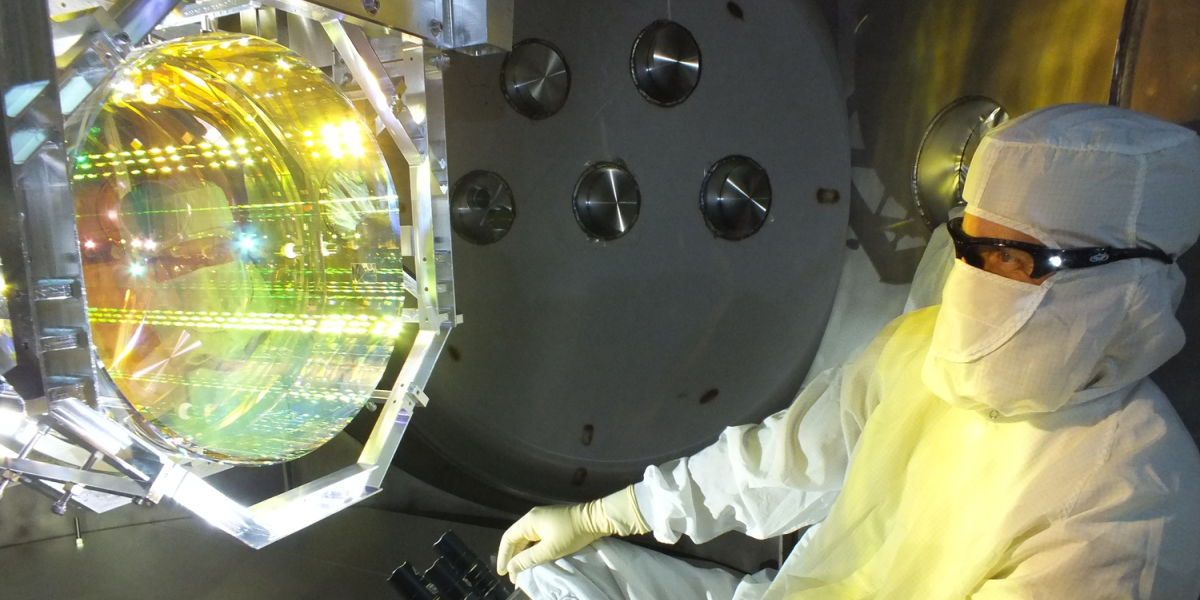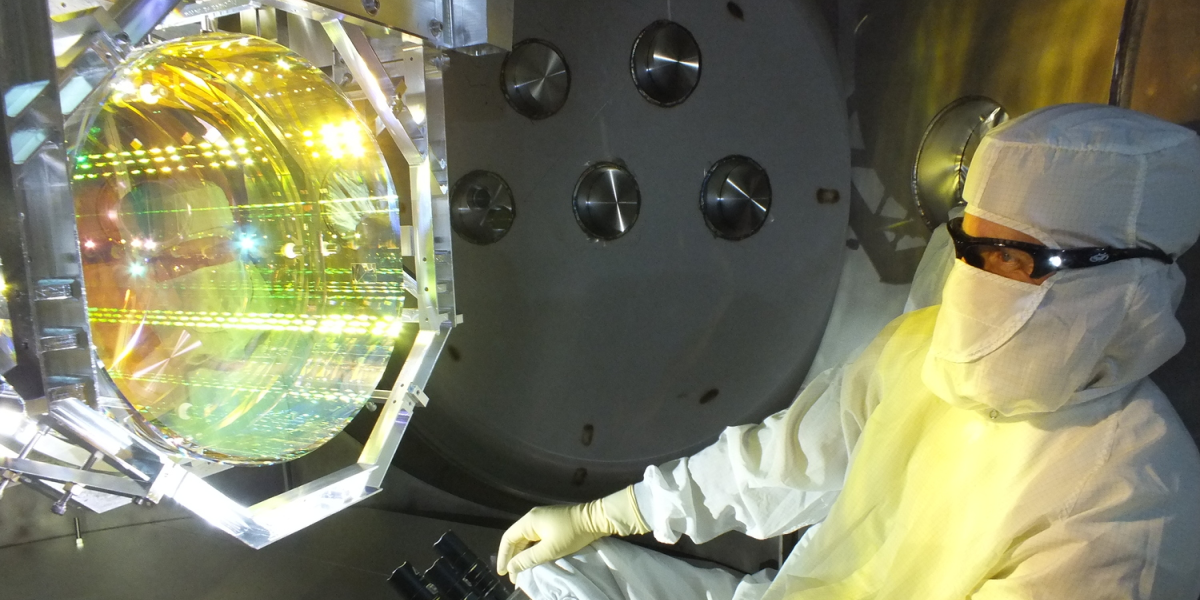Unexpected Noise in Next-Generation Mirror Material
Next-generation gravitational-wave detectors need to be less noisy if they are going to help solve lingering mysteries about black holes and neutron stars. One avenue for reducing noise is to improve the quality of the reflective materials used to determine gravitational-wave-induced length changes in such detectors. Now tests of gallium arsenide, a promising alternative mirror substance, reveal an unexpected amount of noise in the light-reflection properties of thin films made from the material [1]. The experiments were performed at cryogenic temperatures, which are being considered for some—but not all—future gravitational-wave detectors. Further testing is needed to assess the potential impact of this new noise on mirror design choices.
Gravitational-wave detectors are interferometers, in which light bounces back and forth off highly stable mirrors at the two ends of kilometer-long cavities. The passing of a gravitational wave through a detector induces tiny oscillations (smaller than the width of a proton) in the mirror-to-mirror distances. Researchers have detected hundreds of these oscillating signals, known colloquially as chirps, coming primarily from black hole mergers in distant galaxies (see Research News: Black Holes Studied as a Population). Analysis of the chirps can reveal black hole masses and spins, but other information might be retrievable from the data, such as quantum-gravity signals coming from the region near a black hole’s event horizon. “Detecting black hole mergers is not enough,” says Rana Adhikari who works at the California Institute of Technology and for the LIGO Scientific Collaboration on mirror technology. Adhikari was not involved in the new study. “We really want to ‘listen’ to what the black hole horizon is doing.”
To observe those sorts of details, future gravitational-wave detectors aim to reduce mirror noise. Most of that noise currently comes from the thin-film mirror coatings that are responsible for reflecting light within the interferometer cavity. The mirror coatings in LIGO and other in-use gravitational-wave detectors are multilayer structures made from amorphous metal oxides. One of the main sources of noise in these coatings is so-called Brownian thermal noise—a kind of atomic vibration that causes fluctuations in the mirror-to-mirror distances that gravitational-wave detectors monitor. Switching the amorphous material with a crystalline one could help reduce Brownian thermal noise, says Jialiang Yu of Physikalisch-Technische Bundesanstalt (PTB) in Germany.
A promising crystalline mirror material is gallium arsenide. Engineers can create highly reflective coatings by stacking layers of gallium arsenide with a related alloy: aluminum gallium arsenide. These coatings are already in use in small-scale, room-temperature interferometers, where they provide at least a factor of 3 reduction in mirror-related noise compared to amorphous coatings, says Garrett Cole from Thorlabs Crystalline Solutions in California, a developer of crystalline coating technologies. However, there are still open questions relating to the scalability of these coatings, given the large mirror and beam sizes used in kilometer-scale interferometers.
To address some of those questions, Yu and his colleagues carried out a set of precision experiments on gallium arsenide coatings placed in a cryogenically cooled interferometer system kept at temperatures between 4 and 124 K [2]. Lowering the temperatures of the mirrors to these values is a noise-reduction strategy for ultrastable lasers, which is the field of research that Yu and colleagues work in. Cryogenically cooled mirrors are also a design option in gravitational-wave detectors, such as the recently built Kagra experiment in Japan and the planned Einstein Telescope in Europe. The LIGO Scientific Collaboration is considering cryogenically cooled mirrors for a future upgrade, called LIGO Voyager, but room-temperature mirrors are used in the current LIGO detector—as well as in proposed designs such as the Cosmic Explorer in the US.
As expected, the cryogenic experiments of Yu and colleagues indicate that gallium arsenide coatings have low Brownian thermal noise. But the researchers detected two other noise sources, neither of which were predicted. The first additional noise contribution comes from birefringence—a polarization-dependent effect that manifests in the way that light interacts with a material. In their analysis, the researchers found that for gallium arsenide films, this polarization dependence fluctuates in time, leading to noise in measurements of the interferometer’s mirror-to-mirror distance. The origin of the birefringence fluctuations remains unknown, but the researchers show that they can reduce the noise’s impact by exciting two orthogonal laser polarizations in their cavities and averaging together the two interferometric signals.
The second noise contribution remains more of a mystery. Yu and colleagues found that the magnitude of this extra noise remains constant as the laser beam size is varied, which they say implies that fluctuations in one region of the coating are somehow tied to fluctuations in other distant regions. Such “global” noise is uncommon. Other noise contributions, such as Brownian thermal noise, are more localized, which means they can be partly averaged out of the data by using larger beams. Extrapolating how this new global noise might affect next-generation gravitational-wave detectors, the team estimates that it could have a higher magnitude than current noise levels for amorphous coatings in cryogenic systems. Yu says that more experiments are needed at other frequencies, beam sizes, and temperatures, but these preliminary results could have implications for future detector designs. “We want to tell the gravitational-wave community that ‘Hey, there’s something new here. Please be careful,’” he says.
The gravitational-wave community is doing exactly that. “We are investigating and assessing the potential implications [of the results],” says Michele Punturo, a spokesperson for the Einstein Telescope. Punturo points out that gallium arsenide is one candidate material for the detector design, but there are others. “The success of the Einstein Telescope does not rely on gallium arsenide,” he says.
Cole agrees that the new noise is concerning, but thus far it has only been observed at cryogenic temperatures. “We don’t see the polarization issues at room temperature. We don’t see the global noise issue at room temperature.” Indeed, gallium arsenide coatings outperform dielectric coatings in the room-temperature conditions at which LIGO currently operates [3]. For this reason, LIGO is planning for a possible switch from amorphous to crystalline coatings in the near future, says Steven Penn, the chair of the LIGO Scientific Collaboration Council. He says that the noise levels in the gallium arsenide coatings easily meet the requirements of a proposed room-temperature upgrade of LIGO, called LIGO A#. “As with any new line of research, there are many questions that remain to be answered. But the promise of these coatings is sufficiently high that the [National Science Foundation] recently awarded us $1.1 million to explore the main unresolved issues,” he says.
Adhikari remains more skeptical. He agrees that gallium arsenide is currently the most promising material at room temperature. But looking ahead to next-generation detectors, he thinks the new noise contributions could pose a problem for mitigation techniques, such as averaging over the beam spot. He says new mitigation strategies may pop up, but he argues for exploring a range of coating options in parallel. Researchers are studying other crystalline materials, such as gallium phosphide, as well as new types of amorphous multilayers that appear to have less Brownian thermal noise than the ones currently in use. When experiments hit snags, “cleverness ensues,” Adhikari says optimistically.
–Michael Schirber
Michael Schirber is a Corresponding Editor for Physics Magazine based in Lyon, France.
References
- J. Yu et al., “Excess noise and photoinduced effects in highly reflective crystalline mirror coatings,” Phys. Rev. X 13, 041002 (2023).
- D. Kedar et al., “Frequency stability of cryogenic silicon cavities with semiconductor crystalline coatings,” Optica 10, 464 (2023).
- G. D. Cole et al., “Substrate-transferred GaAs/AlGaAs crystalline coatings for gravitational-wave detectors,” Appl. Phys. Lett. 122 (2023).





